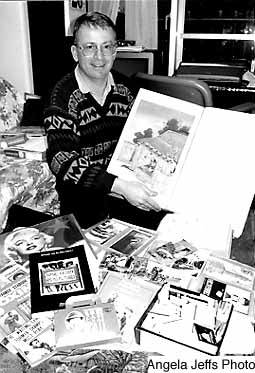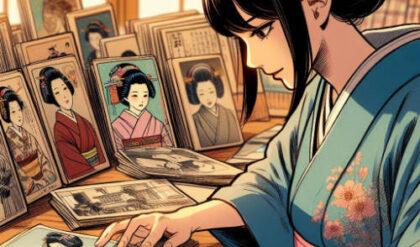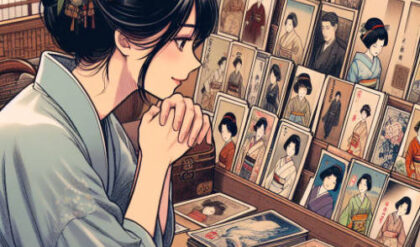In the late 1990s, we had an English-speaking postcard collectors’ club in Tokyo called the Postcard and Paper Collectible Club of Japan founded by Jason P. Smith. It was active with regular meetings, but it soon became defunct after Jason moved away from Tokyo in the early 2000s. While the club was active, we published some postcard collecting information in a newsletter and this newspaper article about Jason Smith also came out.

By Angela Jeffs
This article originally appeared in the People section of the Japan Times on February 2, 1997. The Club thanks Angela Jeffs and the Japan Times for permission to reprint the article here.
Jason Smith, the Tokyo-based founder of the Postcard and Paper Collectible Club of Japan, or PPCCJ, is the first to admit that when he worked in America’s heavy construction industry on major infrastructure projects, he was a bit of a rough diamond.
No longer. He doesn’t drink, smoke or gamble. His only vice– if a vice it be–is a passionate weakness for picture postcards.
Born in Washington, he decided to have a crack at university when he was 31. He chose to major in police science thinking to become a detective. But when he graduated, he realized he was too old to get into the regular force at a decent level, and not cut out for the seedier aspects of private detection.
“So I came to Japan for a holiday,” he said. “I’d always been intrigued, and Japanese friends at university had struck me as being very special people, really quite unique.”
Though he had been collecting for some 20 years in a hit-and-miss kind of way, and owned a couple of books on postcard collecting, he only became truly serious after settling here.
It began with casual visits to flea markets in the Tokyo area to pick up antiques for his sisters and family back in the States. Noticing a lot of postcards and original photo postcards (photographs printed as postcards) and realizing how cheap they were compared to examples back home, he began to buy. This led to talking with other collectors and dealers and establishing the basis of a network of enthusiasts.
After inserting an ad in Tokyo Classified asking collectors to get in touch, a Dutch art broker working in Japan approached him with 1,500 Pierrot cards. Smith was stunned; many were exceedingly rare.
The broker, who is now a good friend, was asking a lot of money, but eventually we worked something out,” he explained. “My Japanese wife, who being a dentist is rather pragmatic in nature, found my interest bewildering–it was still a hell of a lot of money. Later, when she realized what an investment I’d made, she became much more supportive.”
That was one and a half years ago, and since then he has added another 300 cards to the Pierrot collection, mostly from France, England and Italy. He has also started his two small daughters collecting–Disney ephemera. It may seem daft now, but not in 100 years’ time, maybe.
The picture postcard developed as an institution first in Europe and then spread all around the world. In the days before domestic telephones, when privately owned cameras were rare and the radio still a fantasy, postcards were the most popular form of communication and the cheapest holiday souvenir.
Specialty shops stocked postcards only. Collectors formed clubs. Magazines devoted solely to the pursuit (“it’s the thrill of the hunt that is so exciting,” Smith said) were very popular. They still are–abroad. In America, Postcard Collector leads the pack; in the U.K., Picture Postcard Collector has a very healthy circulation.
“In terms of postcard collecting as a hobby, France leads the field, with the United Kingdom ranking second and America third. Back home, in the old days, most families had three books in their possession: the family Bible, the family photo album and the family picture postcard scrapbook,” he said.
Japan hardly figures in the world picture, a fact that may surprise. Collecting telephone cards is huge here, so what happened to postcards and all the other paper collectibles–known in the business as “ephemera”–that continue to hold the attention of the West?
The first postcards in Japan were printed by the government in 1873. Find one of these, and you are on the cutting edge of Meiji history! They took off as a major business early this century during the Russo-Japanese War. Cards showing pretty girls became a lifeline for troops at the front, and others, showing scenes of battles, military leaders and the Emperor, were as much instruments of government then as the media today.
After World War II, interest declined, and now postcards are mainly for foreign tourists. Smith had heard through the grapevine that a collectors’ club existed in Osaka until quite recently, and being in the city this very day on a “look-see” trip, hopes to learn more.
“I can’t believe that there is no other club in Japan today apart from PPCCJ,” he said, shaking his head. The tiny room he calls his own in the family’s apartment in Kinshicho is lined with bookshelves filled with albums of cards, all organized into specialized collections. None of these, he says, he is willing to ever part with. In addition, he has boxes and files of cards he personally finds less interesting but that someone else may well regard as treasures.
He founded the Postcard and Paper Collectible Club of Japan in October 1995, meeting initially in his own home. Now the group–the oldest member 76, the youngest 21, and a mix of Japanese and non-Japanese–gets together once a month halfway between Harajuku and Omote-sando.
Of the 23 members to date, four are what he regards as advanced collectors. Most collect postcards–one older collector, who began as a child, has 20,000 on Yokohama alone. Another man, a senior citizen champion swimmer who used to collect stamps but got bored and sold them, has now transferred his affection to postcards.
“One member collects matchboxes. Another collects “waribashi”–disposable chopsticks–covers. Some people like to collect numbers in sequence on any kind of paper product…the range is very varied,” Smith explained.
“Even among postcard collectors, interests can be diverse. I collect Pierrot, Norman Rockwell, Marilyn Monroe, Alphonse Mucha, transportation, street scenes, anything interesting on Japan and black history. I even have 80 postcards on ostriches!”
Most serious collectors stick very firmly to one area of interest. Smith knows a man who has 20,000 on Japan in general, and another on the lookout for anything picturing newspapers.
Children and toys, flowers and gardens, railways and cars–they are all very sought after abroad. So is social history.
He has the feeling that there are millions of postcards tucked away in homes all over Japan, moldering in the heat and damp–a reaction of paper to the environment that collectors call “foxing.” But this stuff is important: “It’s precious, showing a Japan that no longer exists. We can learn so much about the past, quite apart from any aesthetic merit.”
Although Japan is big on collecting stamps, and for some reason stamps and coins are lumped together for fairs, there are as yet no major events at which postcard collectors can come together to share their enthusiasm and knowledge and do business. It is Smith’s ambition to stage Japan’s first postcard fair, as well as seeing smaller events and clubs springing up all over the country.
PPCCJ will meet next Sunday, then March 9, April 13 and so on through the year. The club’s current newsletter also points members to a good assortment of postcards at the stamp show in Kotsu Kaikan Building from March 20 to 23. The Heiwajima Antique Fair on the same dates is always a bit hit and miss, but some amazing bargains can be found. And of course the JAPEX Stamp Show from April 27 to 29 is a must, with international dealers expected.
Smith welcomes calls from the curious–visitors are equally welcome to come to meetings.
Based in Hayama, Kanagawa Pref., Angela Jeffs (Freelance in Japan) is a writer and The Japan Times columnist. Her postcard collecting interests center on Ainu, foreigners in Japan, Mt. Fuji, Liverpool, and South America.
Postcard Guide Contents
・Introduction
・Japan’s postcard history and how to date old postcards
・Gallery of vintage Japanese postcards – Philbert Ono Collection
・Japanese postcard FAQ – Includes postcard glossary
・Kokkei Shimbun postcards – by Andrew Watt
・Japan Times article on Postcard Club and founder Jason Smith – by Angela Jeffs in 1997
・Book review of postcard books – Meiji Period postcards
・Book review of Yokohama postcard book
・T. Enami – Yokohama-based photographer active in the 1920-30s
・Vintage Postcard Shops in Osaka
・Year Conversion Table – Figure out what year Meiji 5 was, etc.





3 Comments